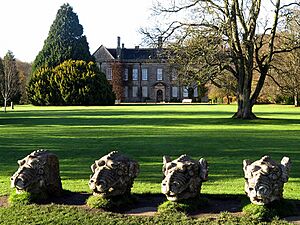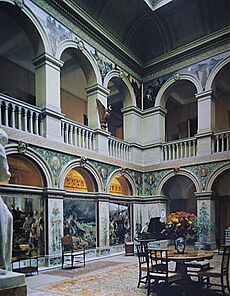Wallington Hall facts for kids
Quick facts for kids Wallington Hall |
|
|---|---|
 |
|
| Type | Country house |
| Location | Cambo |
| OS grid reference | NZ 02880 84191 |
| Area | Northumberland |
| Built | 1688 |
| Rebuilt | 1735–1745 |
| Architect | Daniel Garret |
| Architectural style(s) | Palladian |
| Owner | National Trust |
|
Listed Building – Grade I
|
|
| Official name: Wallington Hall | |
| Designated | 6 May 1952 |
| Reference no. | 1042869 |
| Lua error in Module:Location_map at line 420: attempt to index field 'wikibase' (a nil value). | |
Wallington is a beautiful country house and gardens in Northumberland, England. It is located about 12 miles west of Morpeth, near the village of Cambo. Since 1942, Wallington has been cared for by the National Trust. It was given to them by Sir Charles Philips Trevelyan, 3rd Baronet, along with its land and farms. This was the first time such a large donation was made to the National Trust. Wallington is also a Grade I listed building, which means it is a very important historic site.
Contents
The Story of Wallington Hall
The Wallington estate was owned by the Fenwick family starting in 1475. However, in 1688, Sir John Fenwick, 3rd Baronet faced money problems. He decided to sell his properties to the Blackett family.
Sir John sold Wallington Hall and the remaining family lands to Sir William Blackett. The price was £4,000, plus an extra £2,000 each year for Sir John and his wife, Mary Fenwick, for the rest of their lives. Sir William Blackett was very happy with this deal. He soon discovered lead on the land, which made him very rich.
Building and Rebuilding the Hall
The original house at Wallington was a type of old fortified home called a hall house. It had an even older pele tower, which was a small castle-like building. This ancient tower was taken down when the house was rebuilt. However, the cellars of the early medieval house are still there today.
The house was rebuilt again in a grand Palladian style. This work was done for Sir Walter Calverley-Blackett, 2nd Baronet by an architect named Daniel Garret. Later, in 1777, the house passed to the Trevelyan family.
Famous Visitors and Cultural Hub
When Pauline Jermyn married the famous nature expert Sir Walter Calverley Trevelyan, Wallington Hall became a popular place. They started inviting many important writers and scientists to visit. Wallington became a center for culture. Guests included artists from the Pre-Raphaelite Brotherhood, a group of English painters, poets, and art critics.
Sir Charles Trevelyan, 3rd Baronet took over the property from his father, Sir George Trevelyan, 2nd Baronet, in 1928. Sir Charles was an important member of the Liberal and Labour governments in the late 1920s. He was married to Lady Mary Trevelyan, often called "Molly."
Inside Wallington Hall
Wallington Hall is surrounded by 100 acres (about 40 hectares) of beautiful parkland. This area includes a wooded valley, pretty lakes, green lawns, and a recently updated walled garden.
Inside the house, you can see amazing decorations. The ceilings in the dining and drawing rooms are designed in the rococo style. These were created by an Italian artist named Pietro Lafranchini .
Other interesting things inside the house include the desk where Thomas Babington Macaulay wrote his famous History of England. Thomas Babington Macaulay was the brother-in-law of Sir Charles Trevelyan. There is also a large collection of old dollshouses. In the central hall, you can see eight large murals. These paintings show the history of Northumberland and were created by William Bell Scott.
The National Trust also owns the farms that are part of the Wallington estate. For many years, fresh produce from these farms and others nearby was sold at a farm shop on the site. This farm shop closed in 2012.
Wildlife at Wallington
Wallington estate is a special place for nature and wildlife. There are ongoing projects to help native plants and animals thrive.
Beavers Return to Wallington
In July 2023, a family of beavers was set free in a large 24-hectare area. This area is on a small river called a tributary of the Hart Burn, right in the middle of the estate. This was the third time beavers had been released at a National Trust property. Beavers help create wetlands, which are great for many other species.
Pine Martens and Other Animals
In November 2023, the Vincent Wildlife Trust announced that Wallington estate is one of three "Haven Sites" for their "Martens on the Move" project. This project aims to help pine marten populations grow naturally. They do this by encouraging local communities to get involved across England, Scotland, and Wales. The project received a large grant of £1.2 million from the National Lottery Heritage Fund.
These efforts are part of a bigger, long-term plan called "Wilder Wallington." The goal is to bring back native plants and animals to the estate. It also focuses on restoring peatlands and wetlands and other nature recovery plans. One big aim is to plant one million trees by 2030. So far, about 115,000 trees have already been planted. Other animals that might be brought back to the estate include water voles.
See also
 In Spanish: Wallington Hall para niños
In Spanish: Wallington Hall para niños
- West Grange Hall


